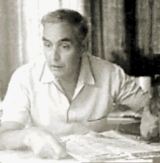
Richard Berger
Encyclopedia

Switzerland
Switzerland name of one of the Swiss cantons. ; ; ; or ), in its full name the Swiss Confederation , is a federal republic consisting of 26 cantons, with Bern as the seat of the federal authorities. The country is situated in Western Europe,Or Central Europe depending on the definition....
professor of design, decoration, and art history. He is best known for his numerous newspaper articles about historical monuments, mainly in the French-speaking part of Switzerland, including his own drawings of the buildings. Through these articles, he contributed to an increased interest in historical monuments and settings among many hitherto uninformed people, and probably also contributed indirectly to a wider interest in preserving and saving historical monuments from destruction.
Around the early 1970s, he published samples of his newspaper writings in books that were, and still are, prized by amateur historians and archeologists. He is read with more caution in university circles, being known as a "vulgarizer" and reflecting essentially the state of knowledge at the period of his publications, chiefly the 1950s. Being an active teacher as well, he wrote papers on heraldry, on the history of the alphabet and on the drawing habits of children.
In 1912, at the age of 18, he became interested in universal languages as an Esperantist
Esperanto
is the most widely spoken constructed international auxiliary language. Its name derives from Doktoro Esperanto , the pseudonym under which L. L. Zamenhof published the first book detailing Esperanto, the Unua Libro, in 1887...
. He changed to Ido
Ido
Ido is a constructed language created with the goal of becoming a universal second language for speakers of different linguistic backgrounds as a language easier to learn than ethnic languages...
in 1918 and to Occidental
Occidental language
The language Occidental, later Interlingue, is a planned language created by the Balto-German naval officer and teacher Edgar de Wahl and published in 1922....
in 1928. He was co-editor of the Occidental magazine "Cosmoglotta" from 1934 to 1950, and he was responsible for changing the name of the language to Interlingue in 1949. Finally, in 1956, he took an interest in Interlingua
Interlingua
Interlingua is an international auxiliary language , developed between 1937 and 1951 by the International Auxiliary Language Association...
.
From January 1959 to December 1963, Berger was secretary general of the Union Mundial pro Interlingua
Union Mundial pro Interlingua
The Union Mundial Pro Interlingua , or UMI, is a global organization that promotes Interlingua, an international auxiliary language published in 1951 by the International Auxiliary Language Association . UMI was founded on July 28, 1955, when the first International Interlingua Congress took place...
(UMI
UMI
UMI may refer to:* Universal Mobile Interface * Universal Metering Interface * Urban Ministries, Inc. * The former name of ProQuest, a microfilm and electronic archive...
) and editor of the Interlingua magazine Currero. He authored more than 20 books about art and historic monuments in Switzerland
Switzerland
Switzerland name of one of the Swiss cantons. ; ; ; or ), in its full name the Swiss Confederation , is a federal republic consisting of 26 cantons, with Bern as the seat of the federal authorities. The country is situated in Western Europe,Or Central Europe depending on the definition....
and a large number of thematic notebooks in Interlingua
Interlingua
Interlingua is an international auxiliary language , developed between 1937 and 1951 by the International Auxiliary Language Association...
, especially on the history of international auxiliary language
International auxiliary language
An international auxiliary language or interlanguage is a language meant for communication between people from different nations who do not share a common native language...
s. He edited the Revista de Interlingua, which ceased with his death, from 1966 to 1983. This magazine grew to more than 6,000 pages sent to 60 countries. As head of his own publishing firm, Editiones Interlingua, he published Interlingua manuals in several languages, ensuring that manuals in the "minor languages" were included.
Europe is divided by the walls of 30 languages. Happily, among these national languages, about 10,000 words of Greek and Latin origin are common. This precious linguistic treasure should be used to the utmost without mutilating a single word or inventing others.
- Revista de Interlingua no 48, 1970
External links
- Biographias: Ric Berger. Historia de Interlingua: Communication Sin Frontieras, 2001, Revised 2006.
- Union Mundial pro Interlingua

